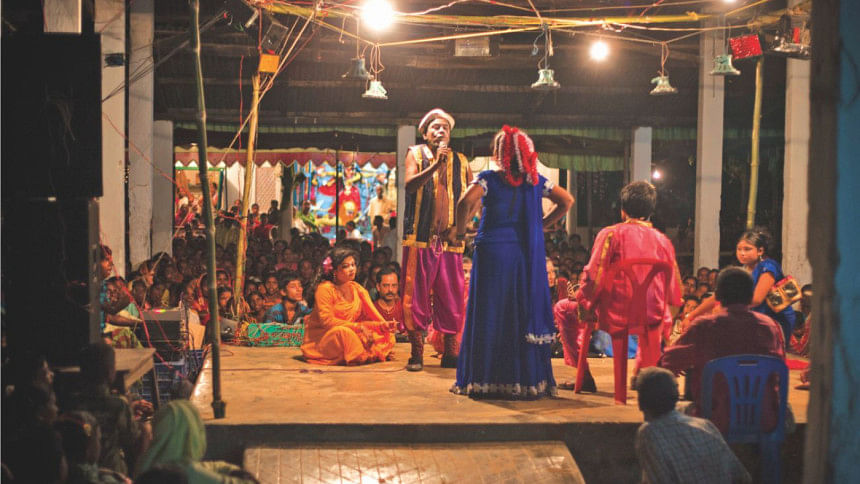Jatra: The Art of Storytelling

For us humans to see, to hear and to feel can never be enough, for experience is meaningless without expression. It is the primeval, instinctive impulse to share one's inner visions, emotions and inspirations, our sense of wonder that is at the root of our reverence for art and our regard for the dramatic. The intense drive to express our rapture or sorrow compelled us to speak in melody, to sing what could be said, for saying is not enough when the need is to tell.
Much of today's art has lost its regard for the purity of expression, having been formalised and thus "syntheticised", under overlying layers of technique, style, special effects and commercial motives. However, performance art forms subsist that forgo the use of props, lighting, and precise dialogue to allow for a deeper expression through the natural tools of the performer: the body and the voice. The indigenous folk theater Jatra has been around for centuries conveying to audiences the truths of life, legends of the past, voices of protest and the marvel of storytelling.
Jatra can be traced back to the sixteenth century, having its beginnings in the dramatic and emphatic worship of the God Krishna by the Chaitanya Mahaprabhu and his followers. The expression of Bhakti or devotion, through dynamic singing and dancing and the enactment of the Leelas (Games) of Krishna from the Hindu scriptures was the original face of folk theatre. Jatra took an even more dynamic form with the beginning of religious processions or Rath Yatras, in which thousands of devotees paraded through villages carrying idols of Gods and Goddesses on enormous chariots.
Jatra's uniqueness as an art form lies in its union of simplicity and emphasis. Since its inception, jatra was performed in rural open-air settings, with the use of natural lighting or simple lanterns. The tradition of having only one chair on stage that serves as a throne or a court room seat, depending on the story reflects the challenge of performers to entertain using only their acting. The lack of lighting and distance between performers and audience explains jatra's use of histrionics, and flashy costumes. The jatra artist must express emotion through his body, movements, facial expressions and the power of voice with intensity and exaggeration so the force of his emotion can reach an otherwise distant audience. Jatra involves improvisation and interaction with the audience and incorporates the bibek (conscience), akin to the choruses of the Greek tragedies, which appears as a detached observer's voice reflecting on the events of the play, guiding the audience to right mode of thought. Jaatra is also referred to as Kabbo Gaan (poetic musicals), with their use of song and dance guided by a number of different musical instruments which augment the moods of the plays.
The term 'Jatra' itself means "Journey" and it is fascinating to trace the journey and evolution of jatra itself from its origins in performances from Hindu mythology to its present day form as a rich and varied style of theatre including historical Palas (plays) such as Mughal e Azam to fictional one's such as Laili Mojnu, dealing with societal and family problems or sentimental romance. The end of the First World War marked the shift within jatra to more secular themes. During this time jatra was being adopted as a medium to protest against colonial rule, seeking to empower the masses with nationalistic fervor to strive against the oppression and class divisions.
Jatra saw its decline with the arrival of mass media. Today around 84 licensed jatra troupes remain in the country. From 1975 jatra began to see a decrease in audience, leading many troupe owners to adopt vulgar dances to attract audiences to sustain their businesses. As a result jatra began to degrade into congregations of young men for the purposes of drinking and gambling. In 1991 the government banned jatra altogether.
"Today much legal restraint involves forming a jatra troupe, and a troupe owner must go through a grueling process of evaluation before getting a license. It is the uncertainty and lack of job security within jatra which is the reason many talented artists are leaving jatra for alternative professions." opines MA Majid, Joint Secretary of Bangladesh Jatra Shilpi Porishod. "Jatra could indeed co-exist with the media as a device for mass communication in rural Bangladesh." He asserts.
Eminent historian and author Dr. Sharifuddin Ahmed says, "The people of our country have always harboured mixed feelings about jatra; nevertheless, we must acknowledge jatra's significance in our cultural evolution worthy of preservation as a historic art form."

 For all latest news, follow The Daily Star's Google News channel.
For all latest news, follow The Daily Star's Google News channel. 



Comments